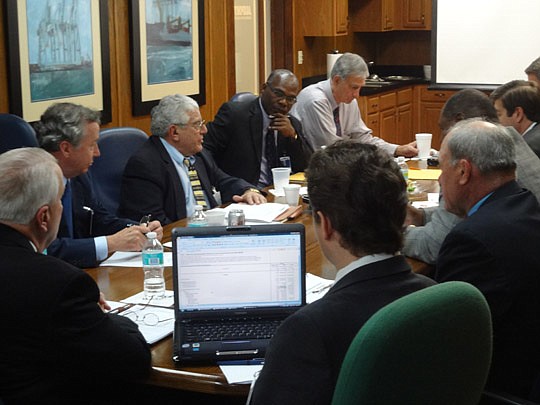
Jerry Mallot, JAX Chamber interim president and JAXUSA Partnership president, said Tuesday the Jacksonville Port Authority board’s decision to pursue a deeper St. Johns River will boost business.
Mallot said the board’s decision to pursue dredging the river to 47 feet from its current 40 feet and more than a recommended 45 feet will keep the port competitive with those in Savannah, Ga., and Charleston, S.C.
“If they (the board) made a choice to not deepen the port a reasonable depth, it would be a choice to say we are not going to compete,” Mallot said.
The port board voted Monday to pursue dredging the St. Johns River to a depth of 47 feet, beyond the 45 feet the U.S. Army Corps of Engineers has recommended.
The locally preferred plan would allow the port to compete with other regional ports for deep-water and Asian cargo business and boost more regional economic impact, according to an assessment presented to the board.
Mallot said the chamber and its economic development division, the JAXUSA Partnership, recruit port-related businesses and the decision to dredge deeper helps sell Jacksonville’s as “in this for the long term.”
Mallot included manufacturing, logistics and distribution industries as focus areas that could benefit.
The decision to compete also carries a higher price tag because the cost difference for dredging and maintaining the additional two feet would be a local cost responsibility.
At the 45-foot depth recommended by the Corps, the federal government would pay 75 percent of the costs and the remaining 25 percent coming locally.
Mallot said he thought the business community will rally around the funding need and work with the City, state and federal governments, while also providing enthusiasm.
Costs to deepen to 45 and 47 feet have not been determined and will be part of the Corps’ review.
The local request for a 47-foot depth will be added to that review, scheduled for a May 6 release to the public.
“We would do a disservice to the citizens of this area, to the Northeast (Florida) region if we did not try to get the most we could get for the port,” said Roy Schleicher, port interim CEO, after the meeting. “If this is going to be a port of the future, it’s going to have to be 47 foot,” he said.
Schleicher said the port would “pull out every stop we can both politically and funding” to reach the 47-foot threshold.
The unanimous board vote was preceded by a presentation by John Martin of Martin Associates that analyzed the depth differences and their opportunities and limitations.
Deepening to 47 feet would allow the Jacksonville port to prioritize becoming a first inbound, last outbound port while increasing opportunities for additional market distribution and logistics centers and manufacturing, the study showed.
Martin’s analysis showed it would lead to 8,113 jobs — direct, induced and indirect — by 2020.
A 45-foot depth would generate 6,774 jobs and the current 40 feet generates 1,339 jobs, it found.
Personal income, in terms of direct, local consumption and indirect, also was higher for the 47-foot depth. Also higher were business revenue, local purchases and state and local tax collections.
Martin said the 45-foot depth did not provide “enough kick” for the board’s desired job creation and his report said the Asian cargo market will be served through a feeder operation and not a first inbound, last outbound port of call under the Corps’ recommended depth.
Such a depth also would mean the “likely” loss of other shipping opportunities, the report showed.
“It’s all about depth. We probably have a multigenerational opportunity,” said board member John Anderson.
“This is an opportunity to realize and embrace the sort of change that is going on and take a shot at it,” he said.
The Corps’ recommendation for 45 feet was based on its formula for a cost-benefit analysis and did not include as many economic projections as Martin Associates.
Several board members praised the local Corps’ efforts but disputed the method it. Schleicher called the Corps’ system “antiquated.”
“They aren’t looking for markets that are outside of our market,” he said. “If the Corps were allowed to take into consideration areas we hit, Raleigh, Atlanta … then those numbers would also look different.”
(904) 356-2466